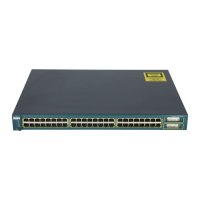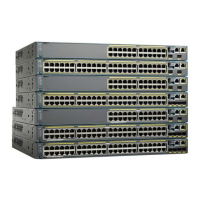Chapter 14: Voice 259
Section 14-2
b. (Layer 3 IOS only) Define the QoS policy:
(global) policy-map policy-name
(pmap) class class-name access-group acl-name
(pmap-class) trust cos
The policy uses a class to match traffic from the ACL. CoS values are then trust-
ed for matching traffic.
c. Apply the QoS policy to the voice VLAN:
(global) interface vlan voice-vlan
(interface) service-policy input policy-name
You can apply the QoS policy to all ports carrying the voice VLAN. This is an
efficient way to use a QoS policy on one specific VLAN within a trunk.
6. Configure voice scheduling on the egress ports.
By default, all frames with CoS 5 are sent to the strict-priority queue. Frames with CoS 3
are sent to the lowest-priority queue. The scheduling map makes sure that the voice con-
trol frames (CoS 3) are sent to a higher-priority queue, serviced ahead of other traffic.
Distribution and Core Layer Configuration
1. Establish a trust boundary.
a. (Optional; Layer 3 only) Trust VLAN-based QoS from an L2 access layer
switch:
(interface) mls qos vlan-based
(interface) mls qos trust cos
A Layer 2 access layer switch can classify and mark traffic based only on Layer 2
CoS values. As well, QoS is applied to the voice VLAN where IP Phone traffic is
carried. A distribution or core layer switch can then apply QoS policies directly
to the voice VLAN.
b. (Optional) Trust QoS from another distribution or core switch or a Layer 3
access layer switch:
IOS L3
(interface) no mls qos vlan-based
(interface) wrr-queue cos-map 2 1 3
IOS L2
(interface) wrr-queue cos-map 2 1 3
IOS L3
(interface) no mls qos vlan-based
(interface) mls qos trust dscp
IOS L2
(interface) no mls qos trust cos
